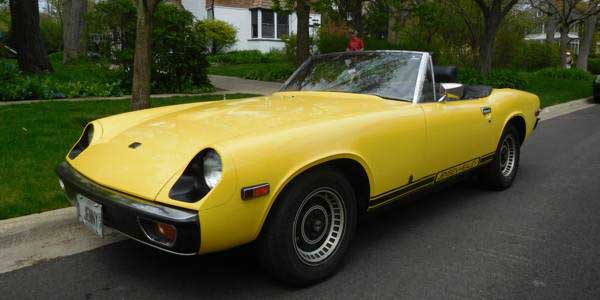
Financial difficulties at British automaker Jensen led to a takeover by a Norwegian-born American car dealer, Kjell Qvale. Donald Healey of Austin-Healey fame became a member of the company’s board of directors, along with his son Geoffrey. As a result of the Healey connection, a new car called the Jensen-Healey debuted at the 1972 Geneva Auto Show.
This all-new two-seat roadster was powered by a Lotus-built twin-cam (16-valve) four-cylinder engine. Its all-steel unibody coachwork had a grille-less front end with recessed headlights. Large amber parking lights sat below the bumper and horizontal rectangular taillights were seen at the rear. The car’s overall profile was angular, with full wheel openings front and rear. Underneath was a mix of British components. The coil-spring front suspension, rack-and-pinion steering and the front disc brakes were borrowed from the Vauxhall Viva. The four-speed manual gearbox came from the Sunbeam.
The Jensen-Healey sold for $4,795 or less than half the price of a Jensen Interceptor. It weighed just 2,116 lbs. The engine was a Lotus-sourced 1973cc in-line four with dual overhead camshafts. It had 95.2 x 69.3 mm bore and stroke measurements. With twin carburetors and 8.4:1 compression, the solid-lifter motor generated 140 hp at 6500 rpm and 130 ft.-lbs. of torque at 5000 rpm.
Qvale and Healey originally wanted to use a Vauxhall engine to power the Jensen-Healey roadster, but it wasn’t strong enough to do the job, so they turned to a the Lotus-built twin-cam derivative that was later used in Lotus cars as well.
Riding a 92-in. wheelbase, the Jensen-Healey was smaller than the Interceptor and comparable to an Austin-Healey 3000. It was 162 in. long overall, 47.75 in. high and 63.25 in. wide. The front tread was 53.25 in., the rear an inch less. It used 185/70SR13 tires. A four-speed manual transmission was fitte. The gear ratios were 11.63:1 in first, 7.42:1 in second, 4.83:1 in third, 3.73:1 in fourth and 12.37:1 in reverse. A 3.73:1 rear axle was standard.
The Jensen-Healey’s front underpinnings featured double wishbones and coil springs. The rear suspension incorporated a rigid axle with four links and coil springs; Power front disc brakes were provided, with drums at the rear. The top speed was in the 120-125 mph range. Going from 0 to 60 took about 8.1 sec. The quarter mile took 16.2 seconds.
In 1973, the Jensen-Healey roadster continued into its first full model year with minor cosmetic changes. Standard equipment included a four-speed manual gearbox, power front disc brakes, a map light, twin Hi-Lo horns, two-speed wiper/washers, a locking glove box, a console, a tonneau cover, a tachometer, a heater and diagonal seat belts. The ventilated vinyl seats were adjustable for rake angle and had adjustable head restraints. The price was now $5,195 and a radio was $135 extra. This year, 3,846 of the cars were built.
A modest restyling of the two-seat roadster took place for 1974. It included the addition of a full-length horizontal body side style line, a curved headlight cowl and some bright trim around the front bumper (including a flashy chrome panel). Bright finishes also were added to the rear edge of the hood and to the door tops. A matte black finish was now used on lower sills and the taillight clusters added chrome surrounds. Two body colors were added: Buttercup Yellow and Malaga Blue. A removable fiberglass roof (with heated back window) became available. There was another price increase in the $350 range, yet production increased to 4,550 units.
By 1974, three out of five Jensen-Healeys were being exported to the U.S. and Canada, though sales never reached anticipated levels. Donald Healey dropped out of the project during this time period and his name did not appear on a new model called the GT Sportwagon. A five-speed Getrag manual gearbox replaced the former four-speed in 1975, but other changes were minimal. Accelearation to 60 mph was slower than before, a result of revised rear-axle ratio. The Jensen-Healey’s price had jumped considerably since the car’s introduction in 1972 and was now up to $8,195. Only 1,301 copies were built.
At mid-year 1975, the roadster was replaced by a new GT Sportwagon model. A handful of Jensen-Healeys were produced during the 1976 model year, but the bulk of production was focused on the new model, a station-wagon-like GT coupe version of the roadster. Billed as “The Good Thinking Car,” it was similar in construction and dimensions to the Jensen-Healey but deleted the Healey name badge. It was priced at $9,975 and weighed in at 2400 lbs.
Unfortunately, the Lotus power plant had reliability problems that contributed to lack of buying interest in the Jensen-Healy and sales were weak. Total Jensen-Healey production from 1972-‘76 was 10,453. The addition of the GT Estate Wagon version didn’t help. By spring 1976, receivers had taken over and the assets of the firm went under the auctioneer’s hammer. A different company was formed to handle parts and service, and, later, import cars into Britain. Actually, the Jensen Parts & Services company hung on well into the 1980s, prepared to custom-build all-new Interceptors based on the 1970s design.
Article courtesy Speedville.


